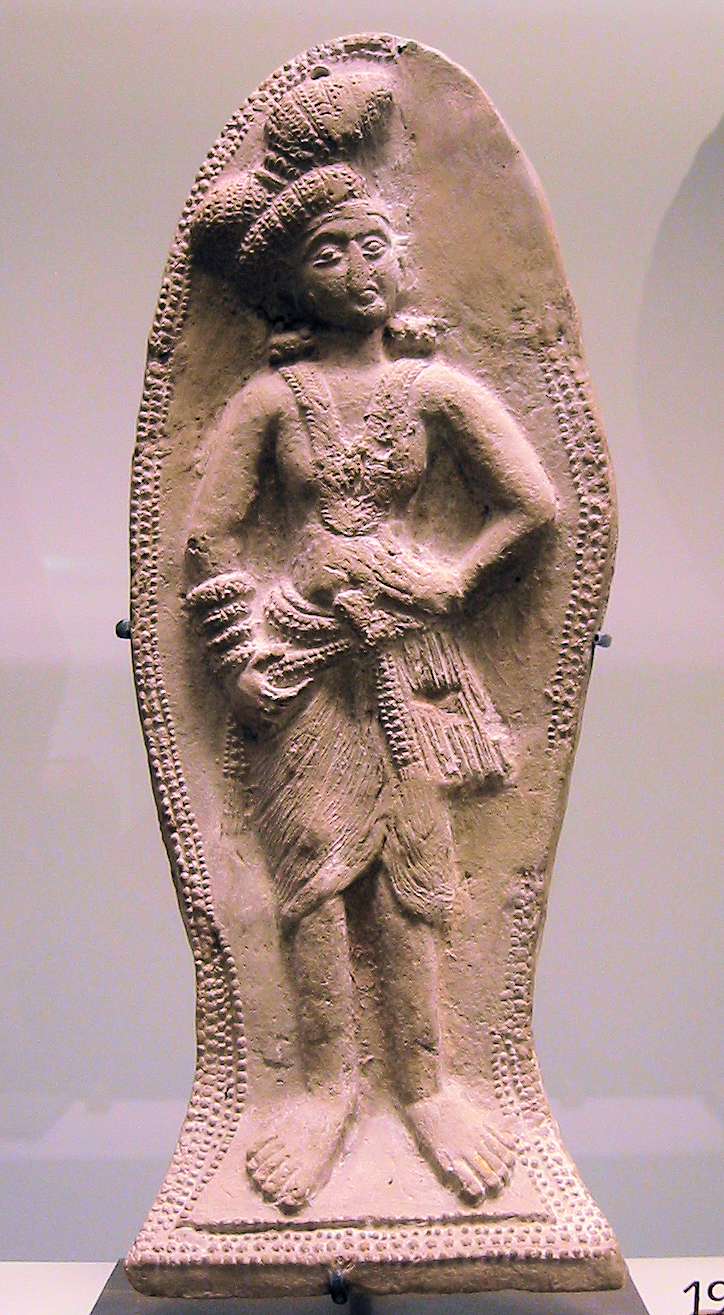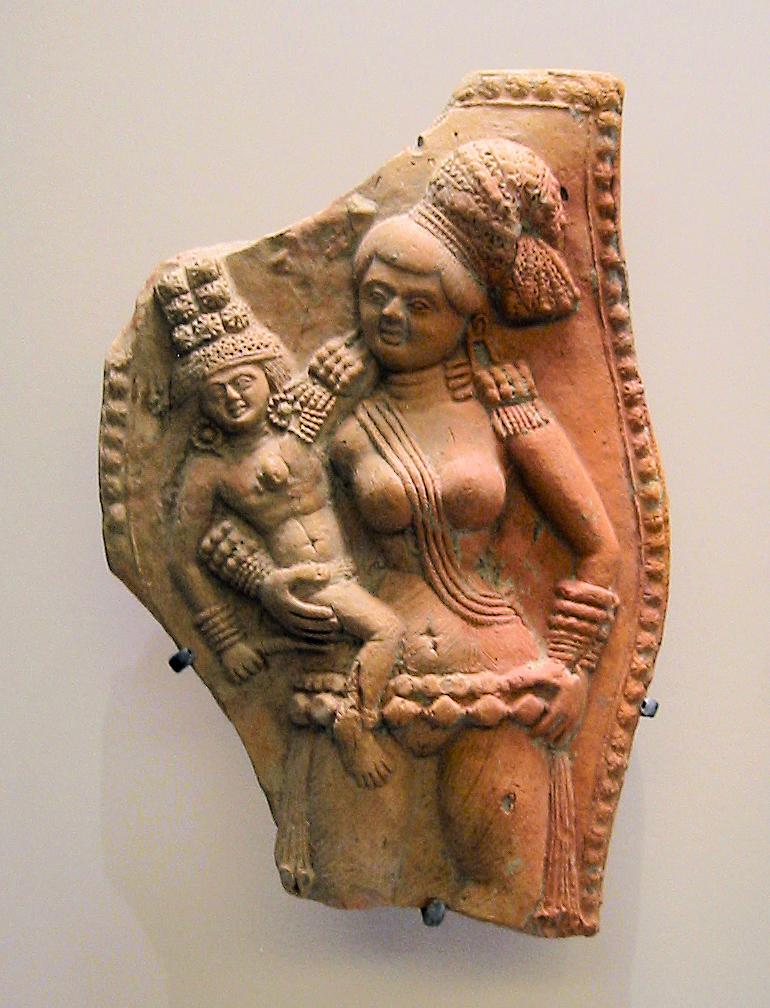Chandraketugarh on:
[Wikipedia]
[Google]
[Amazon]
Chandraketugarh is a 2,500 years old archaeological site located near the Bidyadhari river, about north-east of
 The name of this site is derived from the mythical Hindu king of the medieval period, Chandraketu. A mound at the Berachampa village (Deuliya), off the Barasat-Basirhat Road, used to be called Chandraketur Garh (fort of Chandraketu), which was later compounded as Chandraketugarh. The legend of Khana (A medieval
The name of this site is derived from the mythical Hindu king of the medieval period, Chandraketu. A mound at the Berachampa village (Deuliya), off the Barasat-Basirhat Road, used to be called Chandraketur Garh (fort of Chandraketu), which was later compounded as Chandraketugarh. The legend of Khana (A medieval



* ''Chandraketugarh : A Lost Civilization'' - Gourishankar De and Shubhradip De. Kolkata, Sagnik Books, 2004, 109 p., 34 photos
Banglapedia article
Website concerning Chandraketugarh
Chandraketugarh
A plaque of Chandraketugarh
* ttp://www.rangan-datta.info Rangan Datta's Home Page {{North 24 Parganas District Monuments of National Importance in West Bengal Former populated places in India Archaeological sites in West Bengal North 24 Parganas district Indo-Aryan archaeological sites
Kolkata
Kolkata (, or , ; also known as Calcutta , the official name until 2001) is the capital of the Indian state of West Bengal, on the eastern bank of the Hooghly River west of the border with Bangladesh. It is the primary business, comme ...
, India
India, officially the Republic of India (Hindi: ), is a country in South Asia. It is the seventh-largest country by area, the second-most populous country, and the most populous democracy in the world. Bounded by the Indian Ocean on the so ...
, in the district of North 24 parganas, near the township of Berachampa and the Harua Road railhead
In the UK, railheading refers to the practice of travelling further than necessary to reach a rail service, typically by car. The phenomenon is common among commuters seeking a more convenient journey. Reasons for railheading include, but are ...
. Once it was an important hub of international maritime trade. A museum has been built near the site depicting largely collections of Dilip Kumar Maity, a retired school teacher and amateur archaeologist.
Asutosh Museum of Indian Art conducted excavation between 1957–68, which revealed relics of several historical periods,Dr. Gaurishankar de & Prof. Subhradip de, Prasanga: Pratna-Prantar Chandraketugarh, First Edition: 2013, although the chronological classification of the relics remains incomplete. Many of the Chandraketugarh items and terracottas are now in collections of museums in India and abroad; and many of them are a part of private collections.
According to some historians, the Chandraketugarh site and surrounding area could be the place known to ancient Greek and Roman writers as having the same name as the river Ganges (Γάγγης).
According to the List of Monuments of National Importance in West Bengal
This is a list of Monuments of National Importance (ASI) as officially recognized by and available through the website of the Archaeological Survey of India in the Indian state West Bengal.
(serial no. N-WB-1), Chandraketu's Fort is an ASI listed monument.
Location
Legend
Bengali language
Bengali ( ), generally known by its endonym Bangla (, ), is an Indo-Aryan language native to the Bengal region of South Asia. It is the official, national, and most widely spoken language of Bangladesh and the second most widely spoken o ...
poet and legendary astrologer between the ninth and 12th centuries AD, also named Lilavati elsewhere) centers around her association with Chandraketugarh (here, a mound has been discovered amongst ruins with the names of Khana and Mihir associated with it) and that she was the daughter-in-law of the famous astronomer and mathematician, Varāhamihira
Varāhamihira ( 505 – 587), also called Varāha or Mihira, was an ancient Indian astrologer, astronomer, and polymath who lived in Ujjain (Madhya Pradesh, India). He was born at Kapitba in a Brahmin family, in the Avanti region, roughly co ...
(505 – 587), also called Varaha or Mihira, a jewel among Chandragupta II Vikramaditya's famed Navaratna sabha.
It is widely believed that Khana was Varahamihira's daughter-in-law, and an accomplished astrologer, becoming thereby a potential threat to Varahamihira's scientific career. However, she exceeded him in the accuracy of her predictions, and at some point, either her husband (or father-in-law) or a hired hand (or possibly Khana herself under great duress) cut off her tongue to silence her prodigious talent.
There is another heritage mosque in the name of Pir Gorachand
Pir Gorachand, born Shah Syed Abbas Ali Makki, was an Arab Islamic missionary in Bengal in the 14th Century.
Biography
Makki was born in 1294 in Mecca. He moved towards Bengal with fellow missionary Shah Jalal to preach Islam.
Makki settled in ...
(an Arab
The Arabs (singular: Arab; singular ar, عَرَبِيٌّ, DIN 31635: , , plural ar, عَرَب, DIN 31635: , Arabic pronunciation: ), also known as the Arab people, are an ethnic group mainly inhabiting the Arab world in Western Asia, ...
missionary of 14th century named Syed Abbas Ali).
History
Chandraketugarh is thought to be a part of the ancient kingdomGangaridai
Gangaridai ( gr, Γανγαρίδαι; Latin: ''Gangaridae'') is a term used by the ancient Greco-Roman writers (1st century BCE-2nd century AD) to describe a people or a geographical region of the ancient Indian subcontinent. Some of these wri ...
that was first described by Ptolemy
Claudius Ptolemy (; grc-gre, Πτολεμαῖος, ; la, Claudius Ptolemaeus; AD) was a mathematician, astronomer, astrologer, geographer, and music theorist, who wrote about a dozen scientific treatises, three of which were of importance ...
in his famous work Geographica (150 CE). A recent archaeological study being conducted by a team from IIT Kharagpur, believes that King Sandrocottus (mentioned by Greek explorer Megasthenes) was Chandraketu, whose fort Chandraketugarh is. Megasthenes
Megasthenes ( ; grc, Μεγασθένης, c. 350 BCE– c. 290 BCE) was an ancient Greek historian, diplomat and Indian ethnographer and explorer in the Hellenistic period. He described India in his book '' Indica'', which is now lost, but ha ...
visited India in the third century BC, after Alexandar’s invasion of India, and gives a detailed account of what he saw in Indica. He mentions king Sandrocottus as one of the most powerful kings of Gangaridai
Gangaridai ( gr, Γανγαρίδαι; Latin: ''Gangaridae'') is a term used by the ancient Greco-Roman writers (1st century BCE-2nd century AD) to describe a people or a geographical region of the ancient Indian subcontinent. Some of these wri ...
, the Gangetic delta that spread over the five mouths of the river and was a continuum of a landmass comprising Anga, Banga and Kalinga. The history of Chandraketugarh dates back to almost the 3rd century BC, during the pre-Mauryan era. Artefacts suggest that the site was continuously inhabited and flourished through the Shunga-Kushana period, onwards through the Gupta period and finally into the Pala-Sena period. Archaeological studies suggest that Chandraketugarh was an important town and a port city. It had a high encircling wall complete with a rampart and moat. The residents were involved in various crafts and mercantile activities. Although the religious inclinations of the people are unclear, hints of the beginning of some future cults can be seen in the artefacts. Some of the potteries carry inscriptions in Kharoshthi and Brahmi scripts.
After these periods, there was no such example of any other civilization on the ruin of Chandraketugarh.
Excavated archeological objects



Brahmi
Brahmi (; ; ISO: ''Brāhmī'') is a writing system of ancient South Asia. "Until the late nineteenth century, the script of the Aśokan (non-Kharosthi) inscriptions and its immediate derivatives was referred to by various names such as 'lath' ...
inscriptions with Megalithic Graffiti Symbols
Megalithic markings, megalithic graffiti marks, megalithic symbols or non-Brahmi symbols are markings found on mostly potsherds found in Central India, South India and Sri Lanka during the Megalithic Iron Age period. A number of scholars have tr ...
read "yojanani setuvandhat arddhasatah dvipa tamraparni", meaning "The island of Tamraparni
Tamraparni (Sanskrit for "with copper leaves" or "red-leaved") is an older name for multiple distinct places, including Sri Lanka, Tirunelveli in India, and the Thamirabarani River that flows through Tirunelveli.
As a name for Sri Lanka
The r ...
(ancient Sri Lanka) is at a distance of 50 yojanas from Setuvandha (Rameswaram
Rameswaram (; also transliterated as Ramesvaram, Rameshwaram) is a municipality in the Ramanathapuram district of the Indian state of Tamil Nadu. It is on Pamban Island separated from mainland India by the Pamban channel and is about 40 kil ...
in Tamil Nadu). The mast of a ship with Vijayasinha's seal, describing Vijayasinha, the son of the king of Sinhapura of Vanga's marriage to Kuveni – the indigenous "Yakkha queen of Tamraparni".Sambhu Nath Mondal. 2006. Decipherment of the Indus-Brâhmî Inscriptions of Chandraketugarh (Gangâhrada)--the Mohenjodaro of East India. pp28 vijayasihasa bivaha sihaurata tambapaniah yakkhini kubanna,a" Sanskritized as "vijayasirihasya vivaha sirihapuratah tamraparnyah yaksinf kubarjuaaya" Chandraketugarh features many examples of terracotta
Terracotta, terra cotta, or terra-cotta (; ; ), in its material sense as an earthenware substrate, is a clay-based unglazed or glazed ceramic where the fired body is porous.
In applied art, craft, construction, and architecture, terracotta ...
art, displaying an unusual degree of precision and craftsmanship. These plaques are comparable to those found at other better-known sites such as Kaushambi and Ahichhatra. The terracotta plaques from these sites often carry similar motifs executed in nearly identical fashion. This similarity suggests an established communication link and common cultural heritage among these sites.
Finds include Northern Black Polished Ware
The Northern Black Polished Ware culture (abbreviated NBPW or NBP) is an urban Iron Age Indian culture of the Indian Subcontinent, lasting c. 700–200 BCE (proto NBPW between 1200 and 700 BCE), succeeding the Painted Grey Ware culture and Blac ...
(NBPW) relics, later wares dated from about 400 BC to 100 BC and approximately contemporary with the Maurya
The Maurya Empire, or the Mauryan Empire, was a geographically extensive Iron Age historical power in the Indian subcontinent based in Magadha, having been founded by Chandragupta Maurya in 322 BCE, and existing in loose-knit fashion until 1 ...
period, as well as from the more recent Kushanas
The Kushan Empire ( grc, Βασιλεία Κοσσανῶν; xbc, Κυϸανο, ; sa, कुषाण वंश; Brahmi: , '; BHS: ; xpr, 𐭊𐭅𐭔𐭍 𐭇𐭔𐭕𐭓, ; zh, 貴霜 ) was a syncretic empire, formed by the Yuezhi, i ...
and Gupta periods.
Many silver punch-marked coins and a few gold coins have been unearthed from Chandraketugarh, including a gold coin of Chandragupta-Kumardevi. Many semi-precious stone beads were also found here, along with items made of ivory and bone. Even a few wooden objects have survived.
See also
* Wari-Bateshwar ruins * Shunga Empire *Gangaridai
Gangaridai ( gr, Γανγαρίδαι; Latin: ''Gangaridae'') is a term used by the ancient Greco-Roman writers (1st century BCE-2nd century AD) to describe a people or a geographical region of the ancient Indian subcontinent. Some of these wri ...
* Berachampa
References
* ''Chandraketugarh : A Treasure House of Bengal Terracottas'' - Enamul Haque. Dhaka, The International Centre for Study of Bengal Art, 2001, 416 p., 678 illustrations including 400 in colour, figures, plates, maps,* ''Chandraketugarh : A Lost Civilization'' - Gourishankar De and Shubhradip De. Kolkata, Sagnik Books, 2004, 109 p., 34 photos
External links
Banglapedia article
Website concerning Chandraketugarh
Chandraketugarh
A plaque of Chandraketugarh
* ttp://www.rangan-datta.info Rangan Datta's Home Page {{North 24 Parganas District Monuments of National Importance in West Bengal Former populated places in India Archaeological sites in West Bengal North 24 Parganas district Indo-Aryan archaeological sites